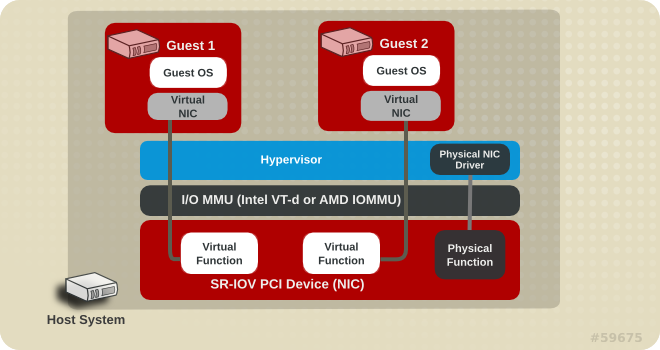Red Hat Training
A Red Hat training course is available for Red Hat Enterprise Linux
Chapter 13. SR-IOV
13.1. Introduction
Developed by the PCI-SIG (PCI Special Interest Group), the Single Root I/O Virtualization (SR-IOV) specification is a standard for a type of PCI device assignment that can share a single device to multiple virtual machines. SR-IOV improves device performance for virtual machines.

Figure 13.1. How SR-IOV works
SR-IOV enables a Single Root Function (for example, a single Ethernet port), to appear as multiple, separate, physical devices. A physical device with SR-IOV capabilities can be configured to appear in the PCI configuration space as multiple functions. Each device has its own configuration space complete with Base Address Registers (BARs).
SR-IOV uses two PCI functions:
- Physical Functions (PFs) are full PCIe devices that include the SR-IOV capabilities. Physical Functions are discovered, managed, and configured as normal PCI devices. Physical Functions configure and manage the SR-IOV functionality by assigning Virtual Functions.
- Virtual Functions (VFs) are simple PCIe functions that only process I/O. Each Virtual Function is derived from a Physical Function. The number of Virtual Functions a device may have is limited by the device hardware. A single Ethernet port, the Physical Device, may map to many Virtual Functions that can be shared to virtual machines.
The hypervisor can map one or more Virtual Functions to a virtual machine. The Virtual Function's configuration space is then mapped to the configuration space presented to the guest.
Each Virtual Function can only be mapped to a single guest at a time, as Virtual Functions require real hardware resources. A virtual machine can have multiple Virtual Functions. A Virtual Function appears as a network card in the same way as a normal network card would appear to an operating system.
The SR-IOV drivers are implemented in the kernel. The core implementation is contained in the PCI subsystem, but there must also be driver support for both the Physical Function (PF) and Virtual Function (VF) devices. An SR-IOV capable device can allocate VFs from a PF. The VFs appear as PCI devices which are backed on the physical PCI device by resources such as queues and register sets.
Advantages of SR-IOV
SR-IOV devices can share a single physical port with multiple virtual machines.
Virtual Functions have near-native performance and provide better performance than paravirtualized drivers and emulated access. Virtual Functions provide data protection between virtual machines on the same physical server as the data is managed and controlled by the hardware.
These features allow for increased virtual machine density on hosts within a data center.
SR-IOV is better able to utilize the bandwidth of devices with multiple guests.

